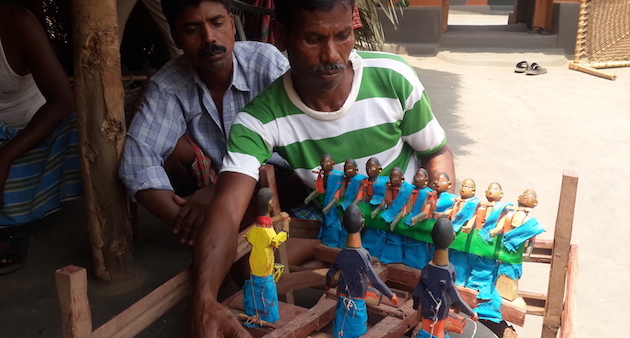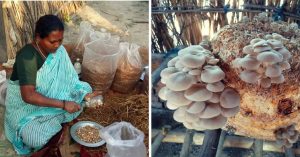TBI Blogs: Meet the Last Practitioners of 2 Indigenous Art Forms from Jharkhand – Chador Badoni and Jadu Patiya
The last few practitioners of Chador Badoni, a form of puppetry, and Jadu Patiya, a form of painting and story telling, say their art forms may soon be lost to modern times unless there is a serious attempt to revive them. Chhandosree takes a closer look.

In the online age, when people are looking for more avenues of entertainment, when the Internet and Google have become easy ways to knowledge and entertainment, two traditional art forms of Santhal Pargana are in for a revival.
Chador Badoni, a form of puppetry, and Jadu Patiya, a form of painting, now limited to some rural pockets in Dumka and practiced by less than a dozen artists in the entire district, tell the tale of how soon they might be be lost to history. An internet search for both art forms yields only nine results for Chador Badoni, out of which only one gives a little information on it, whereas over 3,500 results for Jadu Patiya don’t really throw light on the present status of the beautiful art.
India is known as a land of diverse art and culture. Jharkhand, which was carved out of Bihar on November 15, 2000, too has some special arts that require attention. While the Sohrai and Kohvar paintings of Hazaribagh, falling under the North Chotanagpur division of Jharkhand, have been well-explored and one can see examples of the art on most of the popular boundary walls across Ranchi, the capital of Jharkhand, Jadu Patiya has lost its sheen. The intensity of the art form has not been judiciously used.
Tribal culture
From time immemorial to the pre-independence era in India, both Chador Badoni and Jadu Patiya enjoyed their own value in Santhal villages. Both the forms were used by freedom fighters to reach out to people to induce patriotism, as well as for entertainment.
“Chador Badoni, which means ‘small wooden idol’, is a kind of puppet show. In this, we make small wooden puppets, of both male and female figures, portraying various activities, as per the need of our story and put it on a base for the show,” 50-year-old Babudhan Murmu of Badi Tola, Naoasar village of Hathiapathar panchayat, told VillageSquare.in.
You may also like: TBI Photo Essay-The Varied Hues of Indigenous Art In India.
Being a lone performer from the block, and with none of his three adult sons ready to carry forward the art form, Babudhan feels the art will die soon.
“Making this khancha (frame) which fixes the dhuda (base) and pad (another base to fit the puppets), and every little puppet, is a tedious job. Constructing one frame for Chador Badoni costs around ₹25,000, against which we earn a meager ₹50 to ₹150 a day, carrying it on our heads from home to home for show. We call it bhikari para (asking for money or grains). I start the show from Bhadra maas (around August) and continue showing it till Kali puja (end of October or mid-November),” he said.
Explaining why his sons and others from the young generation don’t take interest, he says, “All of them now have mobiles in their hands. Why would they take interest in seeing something so obsolete? My financial situation prevents me from doing any value addition to the shows, so this art will die soon.”
Magic painters
While Babudhan has his own reasons for announcing that the situation is ominous for Chador Badoni, three Jadu Patiya artists of Naoasar have equal concerns for their paintings, which no one takes interest in learning anymore.
Ganapati Chitrakar (50), eldest of the three, explains the art. “This is one of the oldest forms of paintings for which we still use raw natural colors like geru pathar (a red stone), sim pata (leaves of broad beans), and lamp black. The three are mixed in various ways to produce different colours,” he told VillageSquare.in.
“We shape painting brushes out of thin twigs. Thinking of a concept, we make a song on that concept, and then make a series of paintings, which range from 10-12. We connect each painting using homemade glue, and once all the paintings are complete, we roll them. While performing, we open the roll, show one painting at a time, and sing the story.”
Throwing light on how Jadu Patia got its name, Nitai Chitrakar (40), another painter of the same village, says, “Jadu means ‘magician’ and Patia means ‘painter’. Centuries ago, as my grandfather used to say, the painters used to visit houses where someone had passed away. In the scroll, the dead person’s painting would not have pupils in the eyes, and the family saw the suffering that the soul might go through. To bring back the pupil, the performers sought some daan (donation).”
“In the consecutive scrolls, the dead man would be happy in heaven and the family would get satisfaction and peace.”

But with changes in society, the painters have come up with art based on mythology and folklore. “Yet there are no takers. I make some money only during festival periods. That too ranges around ₹150 to ₹200 a day. For all other purposes then, I am a daily wager,” says Jaydhan Chitrakar (22). He claims his father, late Kamal Chitrakar, was a famous artist who appeared in various global magazines.
Nitai and Ganapati remark that they showcased their talent at a show in Bhopal and Ahmedabad some years ago. There, they received ₹25,000 each, but after that they did not get much attention.
Path of revival
Chador Badoni and Jadu Patia are indigenous and rare forms of art. But the Jharkhand government does not have any action plan or strategy for their revival.
Louis Marandi, the state’s Social Welfare Minister, from the Dumka constituency, denied that the art forms were dying. “Many people are practicing the arts,” he told VillageSquare.in. “We call them during special occasions in Ranchi.” But she failed to say whether the Art & Culture Department has any list of all the artists still practising but not making a living from being daily wagers.
Manik Chandra Mandal (60), an elderly gentleman from Naoasar, made a request with folded hands. “These arts have arisen from our land, please do something for their revival.”
Adapted from an article originally published on VillageSquare.in. Subscribe to VillageSquare’s weekly update on the website for more stories from rural India.
Like this story? Or have something to share? Write to us: [email protected], or connect with us on Facebook and Twitter.
NEW: Click here to get positive news on WhatsApp!
This story made me
- 97
- 121
- 89
- 167
Tell Us More
We bring stories straight from the heart of India, to inspire millions and create a wave of impact. Our positive movement is growing bigger everyday, and we would love for you to join it.
Please contribute whatever you can, every little penny helps our team in bringing you more stories that support dreams and spread hope.



















